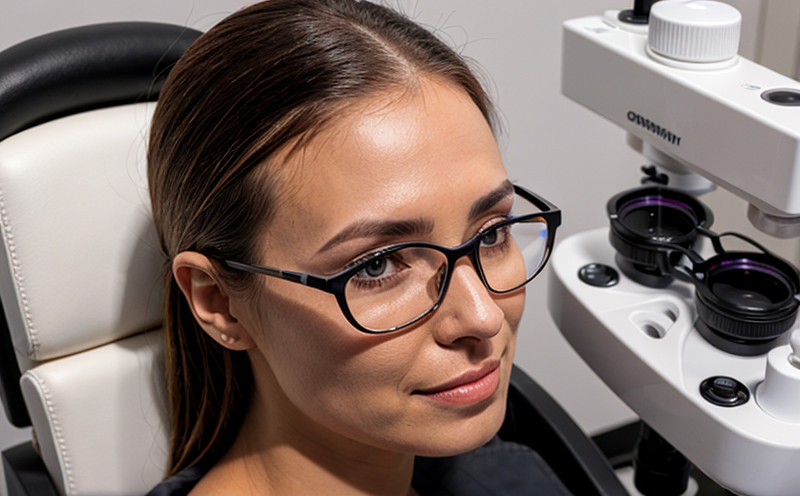ICH Q3B Impurities in Drug Products Testing for Ophthalmics
The ICH Q3B guideline provides a framework for ensuring the safety and quality of ophthalmic drug products by focusing on the analysis of impurities that may be present. This is critical because even trace amounts of certain impurities can have significant adverse effects, especially in sensitive ocular tissues.
Our laboratory adheres strictly to ICH Q3B, using cutting-edge analytical techniques and equipment to ensure accurate identification and quantification of known and potential new impurities within drug products. This service is particularly relevant for pharmaceutical manufacturers who are seeking compliance with international standards or need assurance that their formulations meet strict quality thresholds.
The process begins with meticulous sample preparation tailored to the chemical nature of ophthalmic compounds, ensuring no bias in the subsequent analysis. The chosen analytical methods include but are not limited to HPLC (High-Performance Liquid Chromatography), GC (Gas Chromatography), and ICP-MS (Inductively Coupled Plasma Mass Spectrometry). These techniques allow us to detect even trace levels of impurities that could impact the efficacy or safety of ophthalmic drugs.
Once samples are prepared, they undergo rigorous testing using advanced instrumentation. The selection of analytical methods is based on the specific characteristics and expected impurity profiles of the drug product being analyzed. For instance, when dealing with small molecule APIs (active pharmaceutical ingredients), HPLC might be preferred due to its high sensitivity and ability to separate complex mixtures.
The testing process also includes a validation phase where we ensure that all analytical methods are robust enough to detect impurities down to the limit of quantification specified by ICH Q3B. This involves extensive method optimization, calibration, and linearity checks to guarantee reliable results. Compliance with ICH guidelines is paramount, as these standards set the gold standard for quality assurance in the pharmaceutical industry.
The final step in our service includes comprehensive reporting that not only lists detected impurities but also provides detailed information on their concentration levels, potential sources of contamination, and risk assessments. This report serves multiple purposes—ranging from internal review by R&D teams to supporting regulatory submissions for approval or market clearance.
Our commitment to accuracy and reliability extends beyond mere compliance; it encompasses proactive measures aimed at minimizing risks associated with impurities in ophthalmic products. By leveraging our expertise in this area, clients can rest assured that their products are safe and effective, meeting both industry expectations and regulatory requirements.
Benefits
- Comprehensive analysis of all known impurities to ensure product safety.
- Use of state-of-the-art analytical techniques for precise detection even at trace levels.
- Rigorous validation processes ensuring method robustness and reliability.
- Robust reporting including detailed risk assessments and potential sources of contamination.
By adhering to ICH Q3B, our service helps pharmaceutical companies maintain high standards in drug development and manufacturing. This not only enhances product safety but also supports successful regulatory approvals and market entry strategies.
Quality and Reliability Assurance
- We employ a multi-step process that includes meticulous sample preparation, rigorous testing using advanced instrumentation, and comprehensive reporting.
- All our methods are validated according to the strict criteria set by ICH Q3B, ensuring reliability and accuracy of results.
Our quality assurance measures are designed to uphold the highest standards in pharmaceutical testing. By choosing this service, clients benefit from a systematic approach that minimizes risks associated with impurities, thereby enhancing product safety and regulatory compliance.
Competitive Advantage and Market Impact
The ICH Q3B guideline is not just about meeting regulatory requirements; it’s also about gaining a competitive edge in the global market. By ensuring that our clients’ products meet the stringent quality standards outlined by this guideline, we help them avoid costly recalls and withdrawals. This proactive approach to product safety strengthens brand reputation and fosters consumer trust.
In addition, compliance with ICH Q3B can be a differentiating factor when submitting new drug applications or seeking approval in various regions around the world. It demonstrates a commitment to excellence that is highly valued by regulatory bodies and potential partners alike. Furthermore, our service can contribute significantly to reducing liability risks associated with product impurities.
For R&D teams, this service provides valuable insights into product performance and potential areas for improvement. This information can be crucial in optimizing formulations and developing strategies for minimizing impurity formation during production processes.





